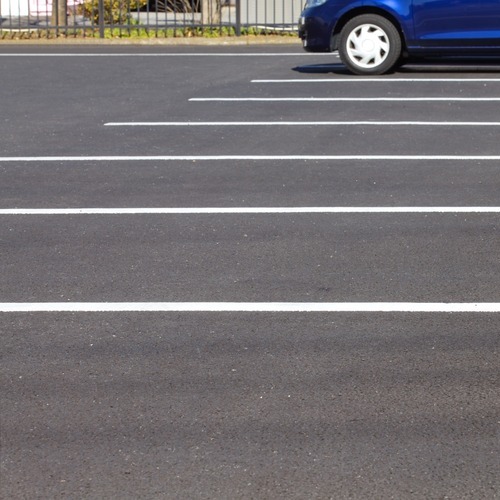
What is the parking lot striping process?
When a new commercial structure is built, the parking lot needs to be defined. This is done by a parking lot striping process. This process is also known as pavement marking or striping which are even, straight lines.
Other than the lines being either yellow or white, there is more to parking lot striping than most drivers realize. Read on as we answer some common questions and provide information you can file away in the “unknown facts and information” to use at the next dinner party. When you need parking lot striping in Waco, TX or any nearby cities, you’ll need a professional like those on our team to help. Bearing that in mind, here are some answers to common questions you’re likely to have about this process.
Who designs the parking lot striping?
You may question their degree, but parking lot striping designs are designed by a civil engineer. This is one of many skills they have learned and acquired. They have learned the elements needed to create a good overall site.
This task may seem to be basic, maybe below the pay grade of a civil engineer, but like anything else that will have multiple drivers depending on it, parking lot design and parking lot striping have to be accurate and with a logical purpose.
How is the layout of parking lot striping lines determined?
Each parking lot is unique, so the most effective layout in each will vary. To determine the layout of parking lot striping lines, it’s important to look at a few key elements that civil engineers use in their design process:
- Entrances and Exits: They consider the direction and how vehicles will be positioned as they enter and exit the parking lot.
- Traffic Flow: The civil engineers have to determine the most efficient way to direct traffic, either one-way or two-way traffic aisles.
- Anticipated Capacity: The civil engineer designing the parking lot striping will examine the general population of the area and determine the number of parking spaces needed.
- Safety and Spacing: The civil engineer who is designing the parking lot striping must consider the safety aspects of the parking lot. While they need to maximize the allotted space, they need to prevent overcrowding as well. This includes making sure vehicles have sufficient space to pull in, pull out, and pass each other on two-way lanes.
This includes designing the parking lot striping for angle parking, parallel parking, and perpendicular parking. The civil engineer designing the parking lot striping may use one of these three or a combination of them.
What are the dimensions for parking lot striping?
In addition to the elements we’ve mentioned, the civil engineer must follow the requirements that are standard for parking spaces within the parking lot striping. Today’s cars require a standard size of 9’ wide x 18’ long. The painted stripes that are designed to separate each space are typically between 5” and 6” wide.
What type of paint is used for parking lot striping?
The parking lot striping provides drivers a pictorial and sign instructions. They are easy-to-follow signs, lines for each parking space, entry points, and exit points, as well as emergency exits, and handicapped parking spaces. When drivers follow these signs and their directions, traffic flows smoothly and accidents are prevented.
Parking lot striping can be done with one of four different paint types. They have different purposes based on the material reflectance, texture, and their longevity. The four types of paint used for parking lot striping are:
- Reflective: This type of paint has glass-like chards added that make it glow in the dark. This is a must-have type of paint for parking lot striping in shipping centers, hospitals, and anywhere there is nighttime driving.
- Water-Based: This type of parking lot striping paint is similar to the paint that children use for crafts. They are an inexpensive option and quick to dry, which allows immediate use by traffic. Because it is water-based, it isn’t weather-resistant. Rain, ice, or snow can wash it off in a short time.
- Oil-Based: With this type of parking lot striping paint, the oil is the binding ingredient and is meant for a long lifespan. Parking lot striping with this type of paint is recommended where the weather has frequent changes because it is a durable paint with a long lifespan. Even in freezing weather with ice, rain, and snow, it will not wash off.
- Thermal Plastic: This is the most expensive type of parking lot striping paint. It requires being heated to melt the plastic content before use. It is a thick paint that has an elegant appearance and is incredibly durable, withstanding harsh weather conditions better than other types of parking lot striping paint.
How is the parking lot striping done?
The company that does the parking lot striping will use highly specialized equipment. This allows the crew to complete the job with accuracy and precision.
To process starts with the line locations drawn by one of three methods:
- By hand
- Stretching string lines
- Other type of letters and markings
Next, prepping the parking lot surface is done by clearing it with an industrial blower that removes any debris, dirt, or leaves. Then the crew will prep the machine with the chosen paint which is either rolled or sprayed on using a guided mechanism that gives the strips a crisp and straight line throughout the entire parking lot.
Keeping It Bright and Straight
The parking lot striping should be reapplied every five years according to the American Asphalt Association. The type of paint you choose, the elements, and the weather can affect this recommendation. And when you need parking lot striping in Waco, TX, remember to reach out to professionals like those on our team to make sure it’s taken care of properly. You can get in touch with our team by calling 254-716-8685.
